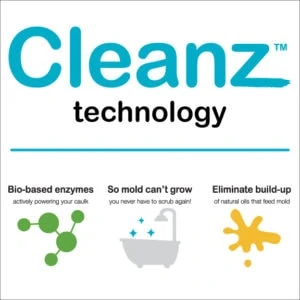You may be wondering why in Burger King’s name we’d compare your cheeseburger to Cleanz® kitchen and bath caulk. The fact is though, they do have something in common! Both depend on enzymes to breakdown fat and oil.
Much like your body requires enzymes to breakdown the greasy cheeseburger, or the fabric stain remover requires enzymes to remove the grease you dripped on your shirt (no judgement here), Cleanz® uses patented bio-enzyme technology to remove body oils, shower products, that collect on caulk and feeds mold. Bio-what?? Allow us to explain.
The oily nature of materials like body oil and bath products allow them to cling to caulk and other surfaces. These oils then build up into soap scum, and mold like a parasite digs its roots in and grows by feeding on the oil deposits. Enzymes like the kind found only in Cleanz® break down oily residue creating water-soluble particles that wash down the drain. When it does, other surface contaminants like scum and mold spores go along with it. There’s nothing left behind on the surface of the caulk to support growth of unwanted mold and mildew.
Scrubbing only removes mold and mildew temporarily because it only affects the outer structure of mold. The inner root structure is still intact and able to grow as soon as you shower again. (Can you say annoying callback?). The key to minimizing these callbacks is to minimize the growth of mold and mildew by removing the oil food source. Cleanz® is the only caulk that can do that! No mold. No mildew. No scrubbing. No brainer!
We’re changing the way you think about caulk (and, now possibly cheeseburgers.) Life if just better when it’s Cleanz®!
Don’t take our word for it, see Cleanz® in action! Visit https://www.sashco.com/products/cleanz/ and click on the video tab to see Cleanz™ working in real time versus competition.







